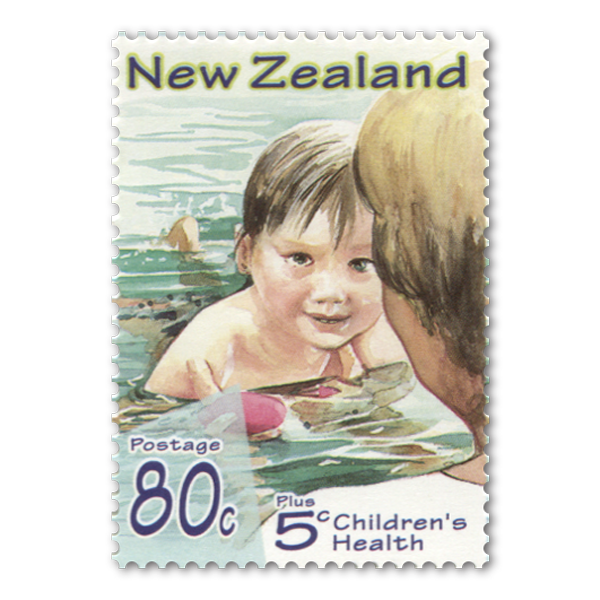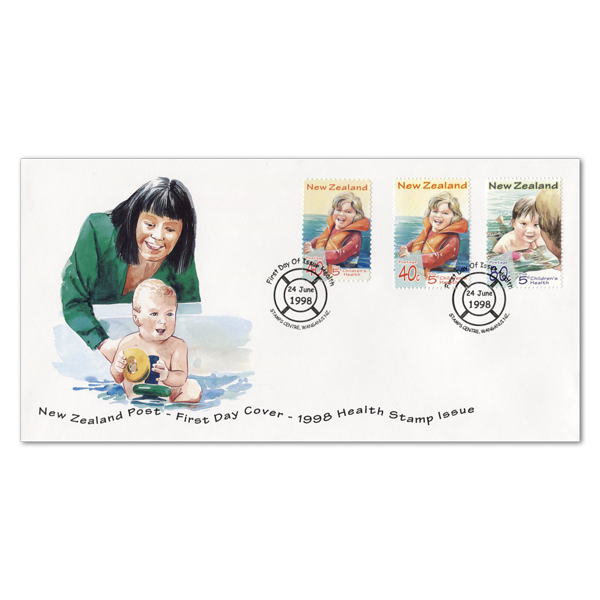New Zealand's Health stamp tradition was nearly 70 years old in 1998. Each year, the 5c surcharge placed on these stamps went to the New Zealand Children’s Health Camps to allow them to continue to provide a safe and happy place for children.
Issue information
Children have featured frequently on the stamps since 1931, and in 1998 the focus was on child safety in water. Though New Zealanders love the water, in 1998 drowning was the third highest cause of accidental death in New Zealand, and the country continued to have one of the highest rates of drowning in the developed world.
Pre-school children swimming at home in pools represented the greatest at risk group in the community. Areas of susceptibility around the house, apart from pools, included containers of water in the back yard, fish ponds, paddling pools and baths. Constant supervision of children when they are around water is the only real means of ensuring water safety.
Swimmers were the second most vunerable group. Programmes such as the the Royal Life Saving Society's Aquapass swim and survive programme provided the means for swimmers to progressively gain the skills required for the wide range of swimming accidents that have occurred in New Zealand.
Boaties using precautions such as always wearing buoyancy aids or life jackets have made a tremendous difference to safety when boating.
The emphasis placed on water safety was led by Water Safety New Zealand (WSNZ) which is the national organisation responsible for ensuring New Zealanders are safe in the water - at home, at the beach, at a lake or river, or out at sea. WSNZ maintained a vigorous education programme aimed at providing life skills to New Zealanders. These initiatives have focused on learning to swim, beach education and boating education.
Awareness of water safety is of paramount importance and that is why in 1998 the stamp designs depicted young children learning to swim and using a life jacket correctly. Both were precautions that all New Zealanders could take to ensure children were safe in or on the water.
Product Listing for 1998 Children's Health - Water Safety
| Image | Title | Description | Price |
|---|---|---|---|
 |
Single Stamp | Single 40c + 5c 'Child in lifejacket' gummed stamp. | $0.45 |
 |
Single Stamp | Single 80c + 5c 'Child learning to swim' gummed stamp. | $0.85 |
 |
Single Stamp | Single 40c + 5c 'Child in lifejacket' self-adhesive stamp. | $0.45 |
 |
Miniature Sheet | Mint, used or cancelled minature sheet. | $2.60 |
 |
First Day Cover | First day cover with stamps affixed. Cancelled on the first day of issue. | $2.25 |
 |
Miniature Sheet First Day Cover | First day cover with miniature sheet affixed. Cancelled on the first day of issue. | $3.10 |
| Self-adhesive Dispenser | Dispenser box containing 100 x 40c + 5c self-adhesive stamps. | $45.00 |
Technical information
| Date of issue: | 24 June 1998 |
|---|---|
| Number of stamps: | Two gummed and one self-adhesive stamp |
| Denominations and designs: | Gummed: 40c (+5c donation) Child in lifejacket, 80c (+5c donation) Child learning to swim; Self-adhesive 40c (+5c donation) Child in lifejacket; Miniature sheet with two 40c (+5c donation) and two 80c (+5c donation) stamps at $2.60 |
| Stamps, first day covers and miniature sheet designed by: | Sea Sky Design, Paraparaumu, New Zealand |
| Printer and process: | Sheet stamps and miniature sheet: Southern Colour Print, Dunedin,New Zealand by lithography; Self-adhesive stamps: Australia Post Sprintpak, Australia by offset lithography |
| Number of colours: | Four process colours |
| Stamp size and format: | Sheet stamps: 28mm x 40mm (vertical); Self-adhesive stamp: 26mm x 37.5mm (vertical) |
| Miniature sheet size: | 125mm x 90mm |
| Paper type: | Gummed stamps and miniature sheet: 103gsm red phosphor coated litho stamp paper; Self-adhesive stamp: B90 self-adhesive stamp paper |
| Number of stamps per sheet: | 100 |
| Perforation gauge: | 14 |
| Cost of unadressed first day cover with miniature sheet: | $3.10 |
| Cost of unadressed first day cover with three stamps: | $2.25 |
| Special blocks: | Plate/imprint, positional or value blocks could be obtained by purchasing at least six sheet stamps. Colour blocks ('traffic lights') were included in plate blocks. Barcode blocks were available in both A and B formats. Special blocks were not available for the self-adhesive stamp. |
| Period of sale: | These stamps remained on sale until 24 June 1999. |

